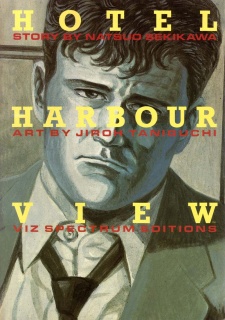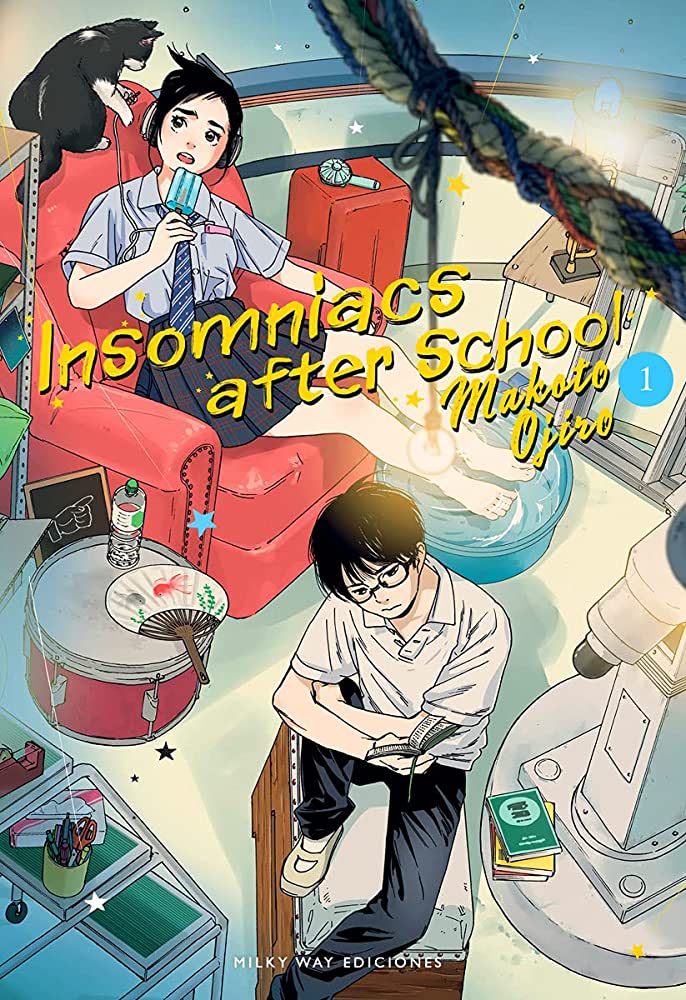Back in 1990, before anyone had hit on the magic formula for selling manga to American readers, VIZ tried a bold experiment. They released a handful of titles in a prestige format with fancy covers, high-quality paper, and a large trim size, and called them “Viz Spectrum Editions.” Only three manga got the Viz Spectrum treatment: Yu Kinutani’s Shion: Blade of the Minstrel, Yukinobu Hoshino’s Saber Tiger, and Natsuo Sekikawa and Jiro Taniguchi’s Hotel Harbour View. While neither the imprint nor the format survived, these three titles helped pave the way for VIZ’s later efforts to establish its Signature line.
Hotel Harbour View, by far the strongest of the three, is a stylish foray into hard-boiled crime fiction. In the title story, a man patronizes a once-elegant bar in Hong Kong, telling the bartender that he’s waiting for the person who’s supposed to kill him, while in the second story, “A Brief Encounter,” an assassin returns to Paris, where his former associates — including his protege — lie in wait for him.
As editor Fred Burke observes in his afterword, both stories are as much about style and genre as they are about exploring what motivates people to kill. The characters in both stories are deeply concerned with scripting their own lives, of behaving the way hit men and high-class call girls do in the movies. None of them wear simple street clothes; all of them are in costume, wearing gloves and suits and garter belts. (In one scene, for example, an assassin asks a bystander to hand him his hat, even though he lies dying in a pool of blood. “Just don’t feel right without it,” he explains.) Their words, too, are carefully chosen; every conversation has the kind of pointed quality of a Dashiell Hammett script, with characters trading quips and telling well-rehearsed stories about their past. A brief surveillance operation, for example, yields this tersely wonderful exchange between two female assassins:
“She’s French, isn’t she? Parisienne.”
“How can you tell?”
“She looks arrogant and stubborn. The sort who ruins men.”
“He loves her. That’s why he came back to Paris.”
“And how can you tell?”
“I’m a Parisienne, too.”
[As an aside, I should note that Gerard Jones and Matt Thorn’s excellent translation brings Sekikawa’s script to life in English; each character has a distinctive voice, and the dialogue is thoroughly idiomatic.]
The violence has a cinematic flavor as well; Taniguchi’s balletic gunfights call to mind the kind of technically dazzling shoot-outs that became a staple of John Woo’s filmmaking in the late 1980s and early 1990s. Taniguchi uses many of the same tricks. He follows a bullet’s trajectory from the gun barrel to its point of impact, showing us the victim’s terrified face as the bullet closes in on its target; stages elaborate duels in which passing trains demand split-second timing from the well-armed participants; and shows us a hit gone bad from dozens of different angles. In one the book’s most stylish sequences, we see a gunman’s reflection in a shattered mirror; as the “camera” pulls back from that initial image, we realize that we’re seeing things from the killer’s point of view, not the gunman’s. A dramatic cascade of glass destroys his reflection as he slumps to the floor — a perfect movie ending for a character obsessed with orchestrating his own death.
Like Taniguchi’s other work, there’s a slightly stiff quality to the artwork. His characters are drawn with meticulous attention to detail, yet their faces remain impassive even when bullets fly and old lovers betray them. That detachment can be frustrating in other contexts, but in Hotel Harbour View it registers as sang-froid; the characters’ composure is as essential to their performances as their costumes and studied banter, as each self-consciously fulfills their role in the drama.
Though Hotel Harbour View is out of print, copies are still widely available through online retailers; I ordered mine directly from Amazon. You’ll also find a robust market for second-hand copies; expect to pay between $4.00 and $20.00 for a copy in good to excellent condition.
Manga Artifacts is a monthly feature exploring older, out-of-print manga published in the 1980s and 1990s. For a fuller description of the series’ purpose, see the inaugural column.
HOTEL HARBOUR VIEW • SCRIPT BY NATSUO SEKIKAWA, ART BY JIRO TANIGUCHI • VIZ MEDIA • 94 pp. • RATING: MATURE (18+)




Jade Harris says:
I also thought the artificial aspect of the hard-boiled content was really interesting. Functionally, it freed up Taniguchi to just roll with it and craft good stories in the genre instead of wasting time justifying why it was worth exploring. It also gave a good look at that era of fiction without any of the sentimentality you tend to find in this sort of historical or genre throwback. Taniguchi explores the genre, acknowledges its death and lays some flowers at its grave. Where sincere efforts to revive the genre like LA Confidential and Mulholland Falls come off a little contrived and judgemental at times, Hotel Harbour View, ironically, came off a lot more sincere through its contrivances.
Plus mature assassin woman kicking ass. Her context in the stories can be nit-picked, but her capability and hard attitude were pretty rare for a woman in entertainment around the globe without some diminishing element stealing all her thunder.
Katherine Dacey says:
You’ve done a better job of explaining why “Hotel Harbour View” works than I did! I couldn’t agree with you more: though it’s obvious that Sekikawa and Taniguchi have a deep love for film noir and hard-boiled fiction, the stories aren’t nostalgia pieces or costume dramas. They’re just good crime stories. And yes, I’m all for stories in which mature women kick ass without apology or exploitation.
David Welsh says:
Have you read Benkei in New York, which Viz also published? If not, I think you’d like it. It’s more conventional than HHV, but it’s got some neat quirks and stylistic flourishes.
Katherine Dacey says:
I own a copy but haven’t read it yet; it’s been languishing on my shelf for months. Sounds like I should dust it off!
Jade Harris says:
Ack, you did a better job remembering that Sekikawa wrote it though. Just add a mental ‘and Sekikawa’ to every instance where I mention Taniguchi. :3
Now that I think more on it, there are definitely lines drawn to HK gun dramas too, like you mentioned, but I realized this story actually proceeds the death of that genre by quite a few years. In that context, I can see a sort of passing of the torch element to the stories too, the new generation of hard-boiled gangsters, colder, hipper and more female than the old. Reading it over twenty years later, it’s a sad hope for a generation of female action-suspense stars that could have been. It reminds me how many steps backwards media has taken in the past decade.
On a side note, I think attempts to revive film noir and hard-boiled fiction fail mainly because they celebrate the environment and era too much, there’s too much nostalgia at play. The genre is really all about man vs. the world. Not only is day-to-day life a pathetic shambles of alcoholism, gambling and unemployment, every shadow could hold some thug ready to jump out and punch you in the face, every dame could be packing a .38 in her garter. Even ignoring the strain of white man indignation that birthed it, it’s just not something you can pull off if the audience has a chance to judge the era or think how cool cars and hats were back then, every car and hat is out to get them and the real catharsis is in seeing the protagonist abide a life that manages to be worse than ours. Chinatown and The Good German work; The Big Lebowski is actually a great modern example too.
So…a big part of what probably helped Hotel Harbour View work was placing hard-boiled fiction in the gun drama setting that was contemporary at the time as it kept the writer from waxing sentimental. Compare the movie Bullet in the Head which was completely mangled when adapted as Blood Brothers set in 1920s Shanghai.
Katherine Dacey says:
I think A Better Tomorrow dates to 1986, which is the same year Hotel Harbour View was written. I didn’t want to suggest a direct influence of Hong Kong cinema on Taniguchi and Sekikawa, since I have no way of knowing what they’d seen, but HHV certainly seems of a piece with John Woo’s work from the period.
Your points about periodization are well-taken. By moving the action to the present-day, you escape the Merchant-Ivory trap, where the author or director becomes so consumed with recreating the period that the drama seems like a secondary consideration. Of course, some of the costumes and hairstyles have a kind of period look to them now; they’re very artful, but the female characters all look vaguely like Those Patrick Nagel prints that were so ubiquitous in the 1980s.
Jade Harris says:
Inspired or no, your comparisons to John Woo are fair and the story does relate a sort of changing of the guards into the underworld action drama of the time. It’s possible that Woo was inspired by Hotel Harbour View. 😀 It was written at the cusp of the popularity of girls with guns stories too, proceeding Nikita by a few years. It’s surprising to learn exactly when it was written though, it was really ahead of its time aside from some of the dated styles.
A historical tragedy can afford to let the audience judge its circumstances from the comfort of their own lives, a whimsical musical can bathe in nostalgia and sentiment, but a bit of the old hard-boiled needs the audience to be able to identify with that hard environment and persevere alongside the protagonist on an equal footing. It just gets to be more of a tightrope walk as the environment becomes more exotic. If you look at, say, Terry Gilliam’s Jabberwocky life really, really sucks, but it’s just too far removed for a modern audience to sympathise, so it’s tough to see it being anything but a farce. Beyond Dennis being a bit too moronical of a take on everyman, it does have all the right elements though. An environment like Boorman’s Excalibur would just be too cool (or cheesy) to provide any real empathy.
Maty says:
I just picked this up in celebration of the ‘moveable feast’, and it certainly haunted me. Taniguchi’s blistering crosshatch work impresses and the fact that the characters all seem to be driven by an unshakeable belief in the infallibility of their own destinies really makes the desperation tactual.
Katherine Dacey says:
…the fact that the characters all seem to be driven by an unshakeable belief in the infallibility of their own destinies really makes the desperation tactual…
That’s a lovely description of this book! In fact, I think I may go re-read it this weekend, even though the Taniguchi MMF is officially over.